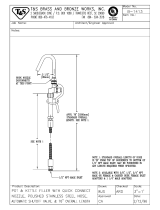13
SPECIFICATIONS/DIMENSIONS
Installation Instructions
These systems conform to NSF/ANSI 44 for the specific capacity claims as verified and substantiated by test data.
* Testing was performed using pellet grade sodium chloride as the regenerant salt.
** Efficiency rating is valid only at the lowest stated salt dosage. These softeners were efficiency rated according to
NSF/ANSI 44.
*** Extent of iron removal may vary with conditions. The capacity to reduce clear water iron is substantiated by WQA
test data. State of Wisconsin requires additional treatment if water supply contains greater than 5 ppm clear water
iron. Use of Diamond Crystal
®
Red•Out
®
or Super Iron Out
®
will improve iron removal. Refer to Cleaning Iron Out
of the Water Softening System section.
**** Canada working pressure limits: 1.4–7.0 kg/cm
2
.
3
3
⁄8″
OUT
INLET–
OUTLET
47
1
⁄2″
41
1
⁄4″
16″
19″
SANITIZING PROCEDURES
To complete the installation, do the following
sanitizing procedures.
Care is taken at the factory to keep your water
softener clean and sanitary. Materials used to make
the softener will not infect or contaminate your water
supply and will not cause bacteria to form or grow.
However, during shipping, storage, installation and
operation, bacteria could get into the softener. For
this reason, sanitizing as follows is suggested when
installing.
NOTE: Sanitizing is recommended by the
Water Quality Association for disinfecting.
1. Be sure to complete all installation steps, including
programming the control.
2. Pour about 3/4 oz. (1
1
⁄2 tablespoons) of common
5.25% unscented household bleach (Clorox, Linco,
Bo Peep, White Sail, Eagle, etc.) into the brinewell.
Refer to illustration on page 5.
3. IMPORTANT: Press and hold for 3 seconds
the faceplate RECHARGE button to start an
immediate recharge. RECHARGE begins to flash in
the display. The bleach will be drawn through the
water softener, and out the drain. This process
takes approximately 2 hours.
4. If, after sanitization, water from the house
faucet tastes salty or has a slight color, this is a
preservative from the resin tank. Turn on the cold
soft water faucets and drain for a few minutes or
until clear.
NOTE: When the sanitizing recharge is over, all
remaining bleach is flushed from the conditioner
and your house COLD water supply is fully soft
immediately. However, your water heater is filled
with hard water and as hot water is used, it will refill
with soft water. When all the hard water is replaced
in the water heater, hot only and mixed hot and cold
water will be fully soft. If you want totally soft water
immediately, after the above recharge, drain the
water heater until the water runs cold.
WARNING: If you do drain the water
heater, use extreme care as the hot water could
cause burns. Turn the water heater off prior to
draining.
INLET
GXSF35E GXSF40H
Rated Capacity* 14,000 grains with 15,300 grains with
2.8 lbs of salt 3.1 lbs of salt
29,600 grains with 33,600 grains with
8.8 lbs of salt 9.8 lbs of salt
35,200 grains with 40,200 grains with
14.7 lbs of salt 16.6 lbs of salt
Rated Efficiency** 5,000 grains/lb. 5,100 grains/lb.
@ 2.8 lbs. of salt @ 3.1 lbs. of salt
Amount of High Capacity Resin (lbs/cu. ft) 47.8/0.92 54.1/1.04
Resin Tank Nominal Size (in., dia. x height) 9 x 40 9 x 40
Service Flow Rate (gpm) 8.5 7.5
Water Supply Maximum Hardness (gpg) 100 110
Water Supply Maximum Clear Water Iron (ppm)*** 6 10
Water Pressure Limits (min.–max. psi)**** 20–125 20–125
Pressure Drop at Rated Service Flow (psig) 15 14
Water Temperature Limits (min.–max. °F) 40–120 40–120
Maximum Flow Rate to Drain (gpm) 2.0 2.0




















